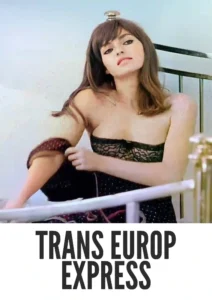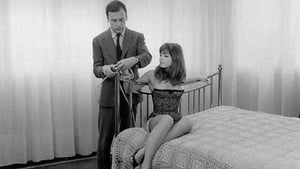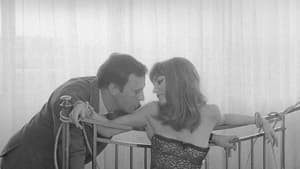Contact: info@alwanfilm.com
Video Sources 0 Views
- Watch trailer
- Trans-Europ-Express


Synopsis
Table of Contents
ToggleReview: Trans-Europ-Express 1966 Colorized – A Stylish and Provocative Thriller on Rails

Introduction
Trans-Europ-Express 1966 emerges as a stylish and provocative thriller that navigates the complexities of identity, reality, and desire against the backdrop of a transcontinental train journey. This article delves into the intricacies of this cinematic gem, exploring its thematic depth, innovative storytelling, and enduring relevance.
Check The Full Colorized Movies List
Check Our Colorized Movies Trailer Channel
Understanding Trans-Europ-Express 1966 Colorized: Director, Cast, and Genre
Directed by Alain Robbe-Grillet, “Trans-Europ-Express” (1966) reflects his penchant for intricate narratives and avant-garde aesthetics. The film features a talented ensemble cast, including Jean-Louis Trintignant, Marie-France Pisier, and Nadine Verdier, whose performances elevate the film’s enigmatic atmosphere. Blurring the lines between reality and fiction, “Trans-Europ-Express” defies easy categorization, straddling the realms of thriller, drama, and experimental cinema with unparalleled finesse.
Exploring the World of Trans-Europ-Express 1966 Colorized: Plot and Characters
At its core, “Trans-Europ-Express” (1966) follows a filmmaker and his scriptwriter as they embark on a train journey from Paris to Antwerp to develop a screenplay. However, their seemingly straightforward trip takes a surreal turn when elements of their fictional narrative bleed into their reality, blurring the boundaries between truth and fiction. As the characters grapple with their identities and desires, the train becomes a microcosm of their inner turmoil, setting the stage for a spellbinding exploration of human nature and cinematic storytelling.
The Art of Cinematic Experimentation
“Trans-Europ-Express” (1966) stands as a testament to the power of cinematic experimentation, with Robbe-Grillet pushing the boundaries of traditional narrative structures and visual storytelling. Through innovative techniques such as split-screen imagery, nonlinear editing, and metafictional storytelling, the film invites viewers on a mesmerizing journey through the labyrinthine corridors of the human psyche, challenging preconceived notions of reality and perception.
Early Experimental Cinema: A Brief History
The history of experimental cinema is marked by a spirit of innovation and rebellion against convention, with filmmakers pushing the boundaries of visual storytelling to explore new realms of artistic expression. From the avant-garde experiments of the early 20th century to the emergence of the French New Wave in the 1960s, experimental filmmakers have continuously challenged audiences to rethink their understanding of cinema and its possibilities.
Trans-Europ-Express 1966 and Its Impact on Film
Trans-Europ-Express 1966 represents a milestone in the evolution of experimental cinema, with its bold narrative structure and surreal imagery paving the way for future generations of filmmakers to explore the boundaries of storytelling and visual aesthetics. By embracing ambiguity and complexity, Robbe-Grillet invites viewers to actively engage with the film’s themes and motifs, fostering a sense of intellectual curiosity and creative exploration.
The Debate Over Experimental Cinema
The debate over experimental cinema is a nuanced and ongoing conversation within the film community, with proponents championing the medium’s capacity for innovation and artistic expression, while detractors question its accessibility and commercial viability. However, as Trans-Europ-Express 1966 demonstrates, experimental cinema has the power to challenge, inspire, and provoke audiences in ways that traditional storytelling cannot, offering a unique and enriching cinematic experience for those willing to embrace its complexities.
Examining Trans-Europ-Express 1966 Colorized as a Cinematic Experience
As viewers immerse themselves in the world of “Trans-Europ-Express” (1966), they are transported into a realm of intrigue, ambiguity, and existential uncertainty. Through its haunting imagery, evocative sound design, and enigmatic narrative, the film invites audiences on a journey of self-discovery and introspection, challenging them to confront their own perceptions of reality and identity.
Influence and Legacy: Trans-Europ-Express 1966 Colorized in Context
Trans-Europ-Express 1966 has left an indelible mark on the landscape of experimental cinema, inspiring filmmakers to explore new avenues of storytelling and visual expression. From its innovative narrative structure to its bold thematic exploration, the film continues to resonate with audiences and critics alike, reaffirming its status as a timeless classic of the genre.
Director’s Cinematic Legacy: Alain Robbe-Grillet’s Influence
Alain Robbe-Grillet’s influence extends far beyond “Trans-Europ-Express” (1966), with a body of work that continues to captivate audiences with its intellectual rigor and artistic innovation. As a leading figure of the French New Wave movement, Robbe-Grillet challenged traditional notions of narrative cinema, pushing the boundaries of storytelling and visual aesthetics in ways that continue to inspire filmmakers around the world.
Themes Explored in Trans-Europ-Express 1966 Colorized
“Trans-Europ-Express” (1966) explores a myriad of themes, from the nature of reality and perception to the relationship between art and life. Through its labyrinthine narrative and dreamlike imagery, the film invites viewers to question their own understanding of truth and fiction, challenging them to embrace ambiguity and uncertainty as essential aspects of the human experience.
Reception and Controversy Surrounding Trans-Europ-Express 1966 Colorized
Upon its release, “Trans-Europ-Express” (1966) received critical acclaim for its bold experimentation and intellectual depth, with many praising its innovative narrative structure and provocative themes. However, the film also sparked controversy among audiences and critics, with some questioning its accessibility and narrative coherence. Nevertheless, “Trans-Europ-Express” (1966) remains a seminal work in the realm of experimental cinema, captivating audiences with its enigmatic storytelling and striking visuals.
Where to Watch Trans-Europ-Express 1966 Colorized Online
For those eager to experience the mesmerizing journey of “Trans-Europ-Express” (1966), the film is available for streaming on various platforms, including Criterion Channel, Amazon Prime Video, and Mubi. Whether viewed on a laptop screen or a high-definition television, the film promises to transport viewers on a thought-provoking odyssey through the corridors of the human mind.
FAQs About Trans-Europ-Express 1966 Colorized
Q: Is “Trans-Europ-Express” (1966) a traditional thriller? A: While “Trans-Europ-Express” (1966) incorporates elements of the thriller genre, it defies easy categorization, blending elements of suspense, drama, and experimental cinema to create a uniquely captivating cinematic experience.
Q: What inspired Alain Robbe-Grillet to make “Trans-Europ-Express” (1966)? A: Alain Robbe-Grillet was inspired by his fascination with the intricacies of narrative structure and the nature of reality. “Trans-Europ-Express” (1966) reflects his interest in exploring the boundaries between truth and fiction, inviting viewers to question their own perceptions of the world around them.
Q: How does “Trans-Europ-Express” (1966) challenge traditional storytelling conventions? A: “Trans-Europ-Express” (1966) challenges traditional storytelling conventions through its nonlinear narrative structure, fragmented imagery, and self-referential elements. By blurring the boundaries between reality and fiction, the film invites viewers to actively engage with the storytelling process and draw their own conclusions about the nature of truth and perception.
Q: What is the significance of the train journey in “Trans-Europ-Express” (1966)? A: The train journey serves as a metaphor for the characters’ psychological and emotional journey, reflecting their inner turmoil and existential uncertainty. As they travel across vast landscapes and through labyrinthine corridors, they confront their deepest desires and fears, ultimately questioning the nature of their own existence.
Conclusion
“In Trans-Europ-Express” (1966), Alain Robbe-Grillet invites viewers on a spellbinding journey through the recesses of the human mind, challenging them to confront their own perceptions of reality and identity. Through its innovative storytelling, striking visuals, and provocative themes, the film remains a timeless masterpiece of experimental cinema, captivating audiences with its enigmatic allure and enduring relevance. As viewers embark on this cinematic odyssey, they are reminded of the power of cinema to provoke thought, stir the imagination, and expand the boundaries of artistic expression.











